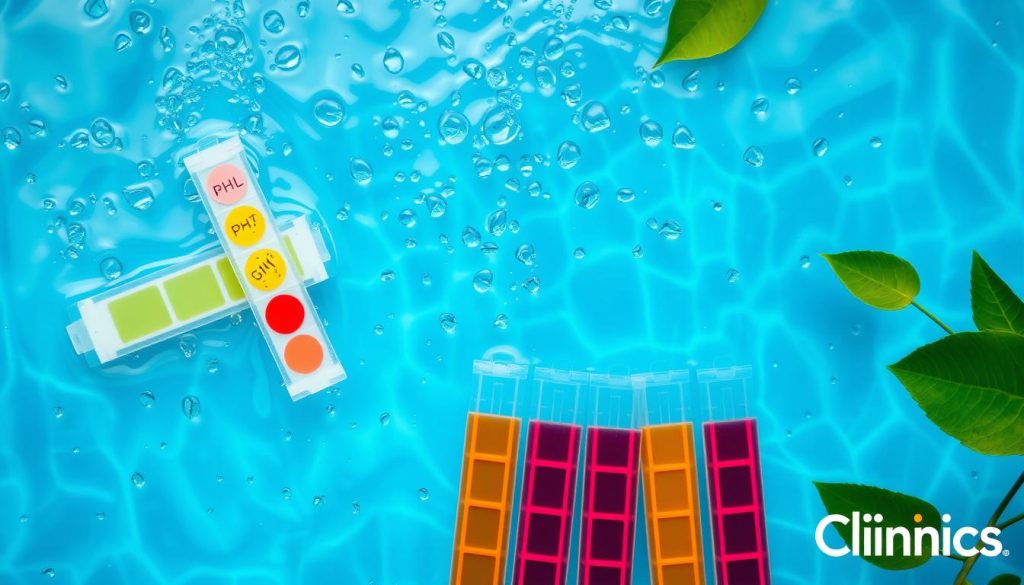
Rain can disrupt our pool’s delicate chemical balance, especially pH levels. Understanding this impact is crucial for safe swimming. We need to maintain proper pool chemistry for our families and friends.
Pool water pH is vital for safety and comfort. Rainwater is naturally acidic and can lower pH levels. This can cause eye and skin irritation.
Low pH may also corrode metal components in your pool. As pool owners, we must stay informed about rain’s effects on pool chemistry. Taking proactive steps helps maintain the ideal balance.
Key Takeaways
- Rainwater can lower pool pH levels due to its natural acidity
- Low pH can cause eye and skin irritation and corrode metal components
- Rain can also affect total alkalinity, leading to pH fluctuations
- Regular water testing is essential to assess the impact of rain on pool chemistry
- Proper pool maintenance after rain includes cleaning debris, adjusting water levels, and balancing pH, alkalinity, and chlorine levels
How Rain Affects Your Pool’s Chemistry
Rain can disrupt the chemical balance in your pool. It impacts sanitizer levels and water safety. Let’s explore how rain affects pool chemistry and what to do about it.

Dilution of Pool Chemicals
Heavy rain dilutes pool chemicals, reducing sanitizer concentrations. This makes pools less effective at killing bacteria and algae. It can lead to cloudy water and increased contamination risk.
An inch of rainfall can increase an 11,000-gallon pool by about 1.5%. This further dilutes the chemical balance in your pool.
| Average Rainfall | Effect on Pool Chemicals |
|---|---|
| 1 inch | Increases pool size by 1.5% |
| 2 inches | Increases pool size by 3% |
| 3 inches | Increases pool size by 4.5% |
Acid Rain and pH Levels
Rainwater is naturally acidic, with a pH below 7. It can range from 6.2 to 4.3 on the pH scale. Ideal pool water pH is between 7.2 and 7.6.
Acidic rainwater can lower pool pH levels. This makes the water more corrosive, potentially damaging equipment and surfaces.
“The best way to prevent drops in pH levels due to acid rain is to ensure that your total alkalinity levels are where they should be.”
Introduction of Contaminants
Rain brings wind, which deposits leaves and debris into pools. This debris introduces phosphates and nitrogen, feeding algae. Many pools experience algae blooms after heavy rain.
Runoff from decks or lawns can change pool water chemistry. It introduces dirt, chemicals, and biological matter that disrupt the water balance.
- Algae can enter pools during rain, potentially causing a green tint in the water and leading to early-stage algae growth.
- Reduced chlorine levels due to rain can increase the risk of bacterial and algal growth.
- Rain can promote the growth of mold and mildew on pool tiles and surfaces.
Does Rain Lower or Raise pH in Pool
Rain can affect pool pH levels in various ways. Its impact depends on the rainwater’s acidity and the pool’s chemical balance. Rainwater is naturally acidic, with a pH between 4.3 and 6.2.
Let’s explore how rain can change pH and alkalinity in your pool.
pH Fluctuations Caused by Rainwater
Rainwater can dilute pool chemicals and alter pH levels. The changes depend on the amount of rain and its acidity. Normal rain has a pH of 5.0 to 5.5.
Pollutants can make rain more acidic, reaching a pH of 4.0. Acid rain is ten times more acidic than rain with a pH of 5.0.
The ideal pH for pool water is between 7.2 and 7.6. Acidic rainwater can lower the pool’s pH, causing a more acidic environment. This can irritate eyes and skin, and corrode pool equipment.
Alkalinity Imbalance and pH Stability
Alkalinity helps stabilize pool pH levels. Rainwater can dilute alkalinity, as it often has very low or zero alkalinity. This can make pH levels more unstable.
Proper alkalinity is crucial for preventing rapid pH changes. The ideal range is 80 to 120 parts per million (ppm). Low alkalinity can cause dramatic pH swings.
| pH Level | Effect on Pool Water |
|---|---|
| Below 7.2 | Too acidic, can cause eye irritation and corrode pool equipment |
| 7.2 to 7.6 | Ideal range for swimming pools, ensures swimmer comfort and chlorine effectiveness |
| Above 7.8 | Too alkaline, can lead to skin irritation, cloudy water, and scale build-up |
Regular water testing is essential, especially after heavy rainfall. Monitor pH and alkalinity levels to keep your pool balanced. Add appropriate chemicals to restore balance and protect your pool from rainwater effects.
Conclusion
Proper pool care is vital for a clean, healthy swimming environment. This is especially true during rainy seasons. Regular testing of pH, chlorine, and alkalinity levels keeps water chemistry balanced.
Shock treatment helps oxidize contaminants and restore chlorine levels. Removing debris through skimming and vacuuming reduces strain on the filtration system. It also prevents staining.
Well-maintained pool equipment ensures proper circulation and filtration after heavy rains. Pumps and filters need regular cleaning and upkeep. These practices help overcome challenges posed by changing weather.
Consistent monitoring is key to keeping pools sparkling year-round. With the right tools, we can manage rain’s impact on pool chemistry. pH modifiers, water treatment granules, and pool clarifiers are essential.
By implementing these maintenance practices, we ensure safe and enjoyable swimming. Our pools can remain inviting, regardless of the weather.







